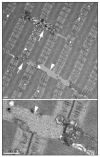When more is less: excess and deficiency of autophagy coexist in skeletal muscle in Pompe disease
- PMID: 19001870
- PMCID: PMC3257549
- DOI: 10.4161/auto.5.1.7293
When more is less: excess and deficiency of autophagy coexist in skeletal muscle in Pompe disease
Abstract
The role of autophagy, a catabolic lysosome-dependent pathway, has recently been recognized in a variety of disorders, including Pompe disease, which results from a deficiency of the glycogen-degrading lysosomal hydrolase acid-alpha glucosidase (GAA). Skeletal and cardiac muscle are most severely affected by the progressive expansion of glycogen-filled lysosomes. In both humans and an animal model of the disease (GAA KO), skeletal muscle pathology also involves massive accumulation of autophagic vesicles and autophagic buildup in the core of myofibers, suggesting an induction of autophagy. Only when we suppressed autophagy in the skeletal muscle of the GAA KO mice did we realize that the excess of autophagy manifests as a functional deficiency. This failure of productive autophagy is responsible for the accumulation of potentially toxic aggregate-prone ubiquitinated proteins, which likely cause profound muscle damage in Pompe mice. Also, by generating muscle-specific autophagy-deficient wild-type mice, we were able to analyze the role of autophagy in healthy skeletal muscle.
Figures


Similar articles
-
Suppression of autophagy in skeletal muscle uncovers the accumulation of ubiquitinated proteins and their potential role in muscle damage in Pompe disease.Hum Mol Genet. 2008 Dec 15;17(24):3897-908. doi: 10.1093/hmg/ddn292. Epub 2008 Sep 9. Hum Mol Genet. 2008. PMID: 18782848 Free PMC article.
-
Autophagy in skeletal muscle: implications for Pompe disease.Int J Clin Pharmacol Ther. 2009;47 Suppl 1(Suppl 1):S42-7. doi: 10.5414/cpp47042. Int J Clin Pharmacol Ther. 2009. PMID: 20040311 Free PMC article. Review.
-
Murine muscle cell models for Pompe disease and their use in studying therapeutic approaches.Mol Genet Metab. 2009 Apr;96(4):208-17. doi: 10.1016/j.ymgme.2008.12.012. Epub 2009 Jan 22. Mol Genet Metab. 2009. PMID: 19167256 Free PMC article.
-
Suppression of mTORC1 activation in acid-α-glucosidase-deficient cells and mice is ameliorated by leucine supplementation.Am J Physiol Regul Integr Comp Physiol. 2014 Nov 15;307(10):R1251-9. doi: 10.1152/ajpregu.00212.2014. Epub 2014 Sep 17. Am J Physiol Regul Integr Comp Physiol. 2014. PMID: 25231351 Free PMC article.
-
Autophagy and mitochondria in Pompe disease: nothing is so new as what has long been forgotten.Am J Med Genet C Semin Med Genet. 2012 Feb 15;160C(1):13-21. doi: 10.1002/ajmg.c.31317. Epub 2012 Jan 17. Am J Med Genet C Semin Med Genet. 2012. PMID: 22253254 Free PMC article. Review.
Cited by
-
The Role of Autophagy in Skeletal Muscle Diseases.Front Physiol. 2021 Mar 25;12:638983. doi: 10.3389/fphys.2021.638983. eCollection 2021. Front Physiol. 2021. PMID: 33841177 Free PMC article. Review.
-
Macroautophagy is defective in mucolipin-1-deficient mouse neurons.Neurobiol Dis. 2010 Nov;40(2):370-7. doi: 10.1016/j.nbd.2010.06.010. Epub 2010 Jun 28. Neurobiol Dis. 2010. PMID: 20600908 Free PMC article.
-
Chaperones in autophagy.Pharmacol Res. 2012 Dec;66(6):484-93. doi: 10.1016/j.phrs.2012.10.002. Epub 2012 Oct 8. Pharmacol Res. 2012. PMID: 23059540 Free PMC article. Review.
-
Muscle Proteomic Profile before and after Enzyme Replacement Therapy in Late-Onset Pompe Disease.Int J Mol Sci. 2021 Mar 11;22(6):2850. doi: 10.3390/ijms22062850. Int J Mol Sci. 2021. PMID: 33799647 Free PMC article.
-
IGF2-tagging of GAA promotes full correction of murine Pompe disease at a clinically relevant dosage of lentiviral gene therapy.Mol Ther Methods Clin Dev. 2022 Sep 24;27:109-130. doi: 10.1016/j.omtm.2022.09.010. eCollection 2022 Dec 8. Mol Ther Methods Clin Dev. 2022. PMID: 36284764 Free PMC article.
References
-
- Levine B, Klionsky DJ. Development by self-digestion: molecular mechanisms and biological functions of autophagy. Dev Cell. 2004;6:463–77. - PubMed
-
- Klionsky DJ. Autophagy: from phenomenology to molecular understanding in less than a decade. Nat Rev Mol Cell Biol. 2007;8:931–7. - PubMed
-
- Mizushima N, Yoshimori T. How to interpret LC3 immunoblotting. Autophagy. 2007;3:542–45. - PubMed
Publication types
MeSH terms
Substances
Grants and funding
LinkOut - more resources
Full Text Sources
Medical
Research Materials
Miscellaneous
